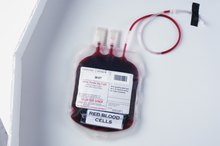The Overall pH of Body Fluid
Fluids in the human body function to provide digestion, lubrication, nutrient and oxygen transportation, and protection. To perform these functions, the acid levels must be varied to match the bodily function. Overall levels of acidity or alkalinity are measured on a pH scale and must be carefully controlled in each body fluid.
The pH Scale
Acidity is defined as the ability of a substance to donate positively charged ions during a chemical reaction. A basic chemical, on the other hand is one that is able to accept the positively charged ions. How acidic or basic a chemical is can be measured on a pH scale that ranges from 0 to 14. The closer the number is to 0 the more acidic the substance is, and the higher the number, the more basic the compound. For example water has a pH of 7, which is neutral. The scale is logarithmic in function, meaning that each whole number increase or decrease changes the potency by 10 times. As such, when a pH changes from 7 to 6 the compound is 10 times more acidic.
Regulation Systems
What Are the Three Buffer Systems in Body Fluid?
Learn More
Biochemical regulation in the human body is done using bicarbonate, phosphate and protein systems. They all work by transferring positively charged hydrogen ions back and forth across cell membranes. Bicarbonate is the main buffer system in various body systems, including blood, stomach, kidneys and the lungs. The reaction that regulates pH level is catalyzed by the enzyme carbonic anhydrase. An increase in the activity of this enzyme leads to an increase in bicarbonate and a basic fluid. Conversely, a decrease leads to a more acidic fluid. Medications that block this enzyme can be used to alter the pH and fluid levels in the body and are routinely used for glaucoma and altitude sickness.
Body Fluids and pH Levels
Saliva, blood and spinal fluid all have a pH of about 7.4. This near neutral level prevents tissue damage that may be caused by levels at either end of the pH scale. Proton pumps that regulate the hydrogen ions in the stomach keep the pH between 1.5 and 3.5. This highly acidic fluid breaks down food and allows digestion to continue. Alterations in any of these systems can lead to serious medical conditions. For example, a pH imbalance in the mouth leads to tooth decay, and alterations in the blood can lead to breathing difficulties. When stomach acid gets beyond the protective sphincter in the esophagus, heart burn and a sour taste may be experienced. The burning sensation is caused by acidic damage to the tissue in the esophagus, and continued acidity may lead to irreversible changes and cancer.
Body Compartments and Fluid pH
Diseases Caused by Alkaline or Acid pH in the Body
Learn More
Body compartments also have mechanisms that regulate the pH level. In the vagina the pH level is kept slightly acidic at 4.3. This level keeps harmful bacteria and fungi from causing symptomatic infections, and any derivations from this averages can help diagnose various diseases such as bacterial vaginosis and candidiasis. The resting pH of the human uterus ranges from 6.6 to 7.6 and is affected by the menstrual cycle. The abdominal and pelvic cavities contain the uterus, ovaries, small intestine and large intestine. These cavities have a pH of 7.4 with variations seen in some diseases such as gastric cancer.
Related Articles
References
- Elmhurst College pH Scale
- "Journal of Reproduction and Fertility";Functional effects of intracellular pH alteration in the human uterus: simultaneous measurements of pH and force;JR Parratt et al.;1995
- "Goodman & Gilman's The Pharmacological Basis of Therapeutics"; Robert F Reilly et al.;2010
- NIH Stomach Acid Test
- University of Sydney Acid Base Control
- "Yonsei Medical Journal";Measurement of Peritoneal Fluid pH in Patients with Non-Serosal Invasive gastric Cancer;Noh Seung-Moo;2003
Writer Bio
Rich Rodriguez, has been published in the "Journal of Pre-Health" and "AUC News." He holds a bachelor's degree in biology and chemistry from the University of Illinois. Rodriguez also earned a Doctor of Medicine from the American University of the Caribbean School of Medicine and obtained a residency in obstetrics and gynecology.








